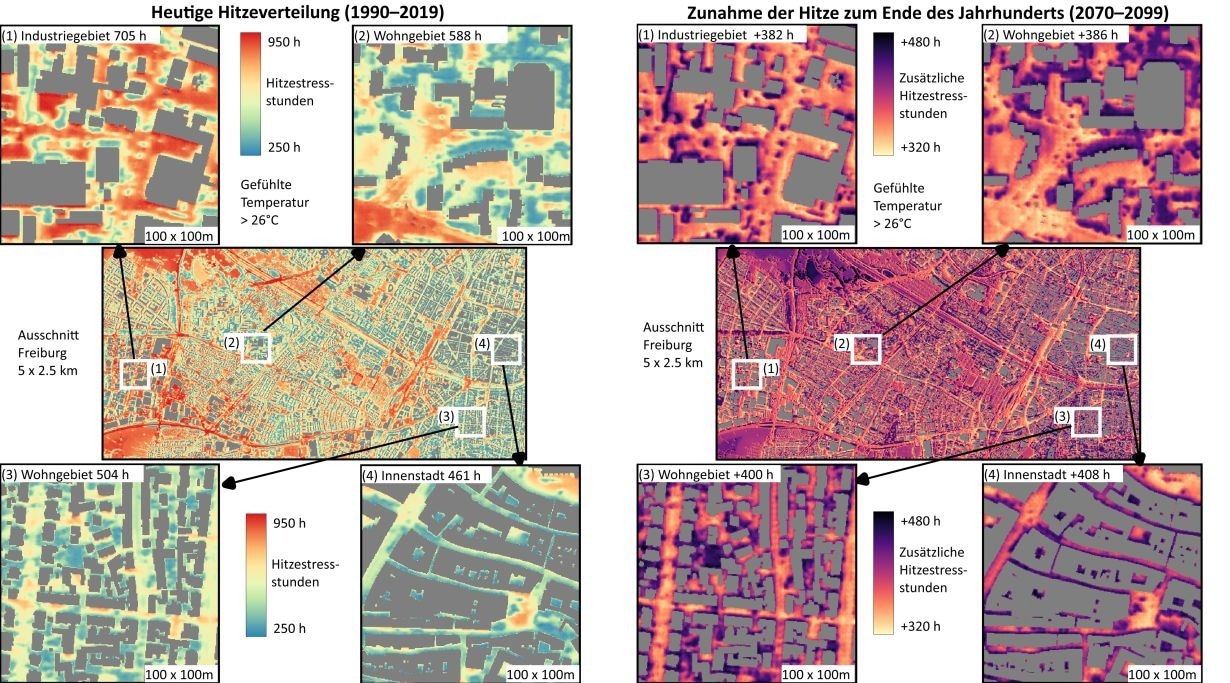By fusing climate projections with city data, scientists reveal how Freiburg’s neighborhoods could face sharp increases in dangerous heat hours, showing how AI can guide tailored strategies to keep urban populations safe.

Using a deep learning model, researchers predict an increase of the heat stress during daytime in cities until the end of the century, compared to today. (Photo: Ferdinand Briegel, KIT)
An interdisciplinary team of researchers from the University of Freiburg and KIT has developed a deep learning model to calculate, at high resolution and over long periods, how heat stress in urban areas will develop per square meter in the future. The reserch is reported in the journal Urban Climate.
The researchers used the city of Freiburg for a case study. The deep-learning system combines geodata, such as building heights and vegetation structures, with weather forecasts or climate projection data, including air temperature and radiation. The model is suitable for predicting various climate scenarios, ranging from a climate where warming is reduced due to effective climate protection measures to a significantly warmer climate resulting from very high greenhouse gas emissions.
Increasing heat stress in Freiburg
Using a deep learning model, the researchers simulated the future urban climate in Freiburg for the period from 2070 to 2099, based on three scenarios. In the most pessimistic scenario, up to 307 hours per year with a strong heat stress of over 32 degrees Celsius "perceived" temperature during the day would be possible. Between 1990 and 2019, the reference period, there were only 135 hours per year. The number of hours with extreme heat stress of over 38 degrees Celsius "perceived" temperature might even increase by a factor of ten: 71 hours a year in the period between 2070 and 2099, compared to seven hours a year during the reference period. In comparison, the number of strong heat stress hours in the lowest-warming scenario only increases to 149 per year. In this scenario, the number of hours with extreme heat stress amounts to twelve.
Factors influencing heat stress
The effects of heat stress within a city are diverse. "Factors such as the density of development, the vegetation, and the air circulation determine whether an area will remain comparably cool or whether the heat accumulates," explains Dr. Ferdinand Briegel, lead author of the study and postdoctoral researcher at KIT's Institute of Meteorology and Climate Research.
Neighborhood-level impacts
The study aims to measure the heat stress affecting representative urban areas in Freiburg, specifically an industrial zone, a residential area with mature trees, and the historic city center, characterized by mid-rise buildings and limited vegetation. The results show that the number of heat hours increases, particularly in industrial zones, due to their many paved surfaces and limited shading. "Densely developed areas with old trees cast shadows during the day so that the heat hours increase moderately. In the night, however, this building and tree structure slows down the cooling process so that the heat stays on," says Briegel.
Applications and future directions
"With our deep learning model, we can analyze heat development virtually in the neighborhood scale," says Professor Andreas Christen, Chair of Environmental Meteorology at the University of Freiburg. "Since each city features its own development, greening, and geographical location, and thus has an individual structure, it is crucial to calculate the heat stress as granularly as possible. This is the only way to develop custom measures that can protect the inhabitants effectively from extreme heat." After validation and adaptation to specific conditions, the model can be customized and used for any other city.
In the next funding period of the Helmholtz Association, urban research will be a central topic for the first time. Cooperations such as this one between KIT and the University of Freiburg demonstrate the importance of networked research for significant future-related issues.
Source:
Journal reference:
- Briegel, F., Schrodi, S., Sulzer, M., Brox, T., Pinto, J. G., & Christen, A. (2025). Deep learning enables city-wide climate projections of street-level heat stress. Urban Climate, 62, 102564. DOI: 10.1016/j.uclim.2025.102564, https://www.sciencedirect.com/science/article/pii/S2212095525002809